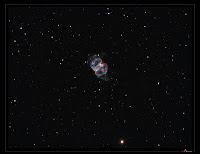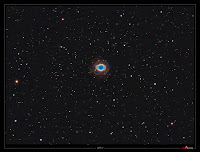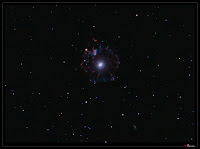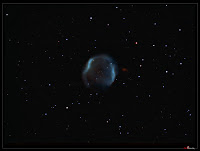COPYRIGHT, PLEASE NOTE
All the material on this website is copyrighted to J-P Metsavainio, if not otherwise stated. Any content on this website may not be reproduced without the author’s permission.
BUY A MUSEUM QUALITY POSTER
BUY A POSTER:https://astroanarchy.zenfolio.com/
Sunday, February 27, 2011
LDN 1622 as a Stereo Pair 3D
Parallel vision 3D
Cross vision 3D
NOTE! This is a personal vision about forms and shapes, based on some known facts and an artistic impression.
Labels:
stereo images
Saturday, February 26, 2011
LDN1622, "Boogie Man Nebula", finalized
LDN 1622, a dark nebula in Orion
Ra 05h 55m 11s Dec +02° 00′ 00"
Natural color composition from the emission of ionized elements, R=80%Hydrogen+20%Sulfur, G=100%Oxygen and B=85%Oxygen+15%Hydrogen to compensate otherwise missing H-beta emission. This composition is very close to a visual spectrum.
At the same night, February 25 ,I shot rest of the lights for Sh2-216 at previous post, I was able to finalize O-III and S-II channels for LDN 1622.
Since this object stays low at here 65N, there is way too little data for a great image. I leave this as it is due the weather. While shooting data, the transparency was bad and that ate out signal very badly. Due that, no HST-palette version this time.
LDN 1622, "Boogie Man Nebula", in Orion is a silhouette of dark nebula at lower half of the image. At background, there is part of the "Parnad's Loop", a large cloud of hydrogen surrounding the nebula complex at Belt and Sword of Orion. LDN 1622 is much closer, than a more famous Orion nebulae, about 500 light years.
This target is very difficult to shoot, since it doesn't rise high, up here 65N. Maximum elevation is only about 27 degrees, at the end of the imaging session, the elevation is only 14 degrees above horizon. I actually had to stop imaging for a while, to avoid a chimney at top of the opposite building. Transparency was poor at the time the data was collected.
Processing work flow:
Image acquisition, MaxiDL v5.07.
Stacked and calibrated in CCDStack.
Levels, curves and color combine in PS CS3.
Equipments:
Tokina AT-X 300mm f2.8 @ f2.8
Platform and guiding, Meade LX200 GPS 12" @ f5
Camera, QHY9
Guider, Lodestar
Image Scale, 3,79 arc seconds/pixel
Exposures:
Baader H-alpha 7nm 12x1200s, binned 1x1
Baader O-III 8,5nm 6x600s, binned 2x2
Baader S-II 8nm 5x600s, binned 2x2
Friday, February 25, 2011
Sh2-216, project finalized
Sh2-216, A planetary Nebula in Perseus, the closest PN to Earth ever discovered
Ra 04h 45m 35s Dec +46° 48′ 30"
Image is in HST-palette, (HST=Hubble Space Telescope) from the emission of ionized elements, R=Sulfur, G=Hydrogen and B=Oxygen. Star colors are mixed from the NB channels, Red=H-a, G=O-III and B= 85%O-III + 15%H-a. Total exposure time 17h
In this image, three emission lines are shown. Ionized Hydrohen (H-a) as Green, ionized Sulfur (S-II) as Red and ionized Oxygen (O-III) as Blue.
S-II region seems to be more expanded than H-a region, O-II is mainly in upper part of the PN but there is some at Right, at between the hydrogen filaments. H-a seems to be little more expanded at the Left side of the nebula, much more dimmer, than a Right side though.
This must be one of the dimmest targets I ever have shot!
I never have seen this target as a three band emission color image before, as far as I know, this must be the first! Generally there is very few images of this to compare, please, let me know, if you have seen this before as a narrowband three color image.
( Actually I have shot this one before, together with a SNR Sh2-221 back in March 2009)
( Actually I have shot this one before, together with a SNR Sh2-221 back in March 2009)
Natural color composition from the emission of ionized elements, R=80%Hydrogen+20%Sulfur, G=100%Oxygen and B=85%Oxygen+15%Hydrogen to compensate otherwise missing H-beta emission. This composition is very close to a visual spectrum.
All three channels, Ha, S-II & O-III, as an animation
All three channels, Ha, S-II & O-III, as an animation
As astronomical cameras are usually gray scale CCD's, colors are made by imaging each of them separately, trough a filter. Color channels, usually three of them, are then composed to a final color image.
In this animation, used channels are shown one by one.
Processing work flow:
Image acquisition, MaxiDL v5.07.
Stacked and calibrated in CCDStack.
Levels, curves and color combine in PS CS3.
Equipments:
Tokina AT-X 300mm f2.8 @ f2.8
Platform and guiding, Meade LX200 GPS 12" @ f5
Camera, QHY9
Guider, Lodestar
Image Scale, 3,79 arc seconds/pixel
Exposures:
Baader H-alpha 7nm 30x1200s, binned 1x1
Baader O-III 8,5nm 17x600s, binned 2x2
Baader S-II 8nm 25x600s, binned 2x2
Total exposure time 17h
I have shot this target before, March 2009, with even wider field.
http://astroanarchy.blogspot.com/2011/01/two-ways-to-end-life-planetary-nebula.html
At this image Sh2-216 can be seen with its neighbor, Sh2-221, a Supernova remnant. .
http://astroanarchy.blogspot.com/2011/01/two-ways-to-end-life-planetary-nebula.html
At this image Sh2-216 can be seen with its neighbor, Sh2-221, a Supernova remnant. .
Wednesday, February 23, 2011
Start of the new projects, Sh2-216 & LDN 1622
This time I'll work with two objects, since LDN 1622 is very low up here, 65 North. I can shoot about two and half hours, before it's too low. My second target for rest of the night is Sharpless 216, an extremely faint planetary nebula. Both projects have been started at 20.02.
LDN 1622, a dark nebula in Orion
Ra 05h 55m 11s Dec +02° 00′ 00"
A gray scale image of H-alpha emission. I'll shoot rest of the emission lines, needed for a color image, later.
LDN 1622, "Boogie Man Nebula", in Orion is a silhouette of dark nebula at lower half of the image. At background, there is part of the "Parnad's Loop", a large cloud of hydrogen surrounding the nebula complex at Belt and Sword of Orion. LDN 1622 is much closer, than a more famous Orion nebulae, about 500 light years.
This target is very difficult to shoot, since it doesn't rise high, up here 65N. Maximum elevation is only about 27 degrees, at the end of the imaging session, the elevation is only 14 degrees above horizon. I actually had to stop imaging for a while, to avoid a chimney at top of the opposite building.
This target is very difficult to shoot, since it doesn't rise high, up here 65N. Maximum elevation is only about 27 degrees, at the end of the imaging session, the elevation is only 14 degrees above horizon. I actually had to stop imaging for a while, to avoid a chimney at top of the opposite building.
Processing work flow:
Image acquisition, MaxiDL v5.07.
Stacked and calibrated in CCDStack.
Levels, curves and color combine in PS CS3.
Equipments:
Tokina AT-X 300mm f2.8 @ f2.8
Platform and guiding, Meade LX200 GPS 12" @ f5
Camera, QHY9
Guider, Lodestar
Image Scale, 3,79 arc seconds/pixel
Exposures:
Baader H-alpha 7nm 12x1200s, binned 1x1
Sh2-216, A planetary Nebula in Perseus
Ra 04h 45m 35s Dec +46° 48′ 30"
A gray scale image of H-alpha emission. I'll shoot rest of the emission lines, needed for a color image, later.
Sharpless 216 (aka Simeis 288, Marsalkova 44, LBN 742, GN 04.41.3) is a closest known planetary nebula and also one of the oldest known. Due the old age, it's very diffused, dim and large, apparent diameter is about 1,6 degrees. This must be one of the dimmest targets I ever have shot!
Processing work flow:
Image acquisition, MaxiDL v5.07.
Stacked and calibrated in CCDStack.
Levels, curves and color combine in PS CS3.
Equipments:
Tokina AT-X 300mm f2.8 @ f2.8
Platform and guiding, Meade LX200 GPS 12" @ f5
Camera, QHY9
Guider, Lodestar
Image Scale, 3,79 arc seconds/pixel
Exposures:
Baader H-alpha 7nm 30x1200s, binned 1x1 (10h)
Monday, February 21, 2011
Sh2-132 as a Stereo Pair 3D
Parallel vision 3D
Cross vision 3D
http://astroanarchy.blogspot.com/2011/02/sh2-132-project-finalized.html
NOTE! This is a personal vision about forms and shapes, based on some known facts and an artistic impression.
NOTE! This is a personal vision about forms and shapes, based on some known facts and an artistic impression.
HOW?
I have been asked many times, how my 3D-images are done, so here it goes!
All the original 2D-images are imaged by me, if not otherwise noted.
Due the huge distances, no real parallax can be imaged to form a volumetric information.
I have developed a method to turn any 2D-astronomical image to a various 3D-formats. The result is always an approximation of the reality, based on some known facts and an artistic impression.
What are the known facts?
By using a scientifically estimated distance of the object, I can organize right amount of stars front and behind the object. (as then we know the absolute position of an object at our Milky-way)
Stars are divided to groups by apparent brightness, that can be used as a draft distance indicator, brighter the closer. There usually is a known star cluster or a star(s) coursing the ionization and they can be placed in right relative position to the nebula itself .
Generally emission nebulae are not lit by the starlight directly but radiation from stars ionizing gases in the nebula. Hence the nebula itself is emitting its own light, typical to each element. Due that, the thickness of the nebula can be estimated by its brightness, thicker = brighter.
Many other relative distances can be figured out just carefully studying the image, like dark nebulae must be front of bright ones. The local stellar wind, radiation pressure, from the star cluster, shapes the nebula, For that reson, pillar like formations must point to a cluster. Same radiation pressure usually forms kind of cavitation, at the nebulosa, around the star cluster, by blowing away all the gas around the source of stellar wind. That and many other small indicators can be found by carefully studying the image itself.
The artistic part is then mixed to a scientific part, rest is very much like a sculpting.
WHY?
All the original 2D-images are imaged by me, if not otherwise noted.
Due the huge distances, no real parallax can be imaged to form a volumetric information.
I have developed a method to turn any 2D-astronomical image to a various 3D-formats. The result is always an approximation of the reality, based on some known facts and an artistic impression.
What are the known facts?
By using a scientifically estimated distance of the object, I can organize right amount of stars front and behind the object. (as then we know the absolute position of an object at our Milky-way)
Stars are divided to groups by apparent brightness, that can be used as a draft distance indicator, brighter the closer. There usually is a known star cluster or a star(s) coursing the ionization and they can be placed in right relative position to the nebula itself .
Generally emission nebulae are not lit by the starlight directly but radiation from stars ionizing gases in the nebula. Hence the nebula itself is emitting its own light, typical to each element. Due that, the thickness of the nebula can be estimated by its brightness, thicker = brighter.
Many other relative distances can be figured out just carefully studying the image, like dark nebulae must be front of bright ones. The local stellar wind, radiation pressure, from the star cluster, shapes the nebula, For that reson, pillar like formations must point to a cluster. Same radiation pressure usually forms kind of cavitation, at the nebulosa, around the star cluster, by blowing away all the gas around the source of stellar wind. That and many other small indicators can be found by carefully studying the image itself.
The artistic part is then mixed to a scientific part, rest is very much like a sculpting.
WHY?
Many times images of nebulae looks like paintings on the canvas. I like to show a real nature of those distant objects as a three dimensional shapes floating in a three dimensional volume. This is a great way to show, how I personally see astronomical targets as a 3D-forms.
3D-experiments seems to increase a public interest to a subject, as you might have noticed.
I have studied my astronomical images much deeper, than ever without 3D-modeling.
3D-studies has really added a new dimension to my hobby as an astronomical photographer. (pun intended)
Labels:
stereo images
Sh2-132 as an anaglyph Red/Cyan 3D
You'll need Red/Cyan Eyeglasses to be able to see this image right.
Note, if you have a Red and Blue filters, you can use them! Red goes to Left eye.
Other 3D-formats:
Original 2D:
NOTE! This is a personal vision about forms and shapes, based on some known facts and an artistic impression.
Labels:
anaglyph images and movies
IC 1848, the "Soul Nebula", as a Stereo Pair 3D
Parallel vision 3D
Cross vision 3D
Other 3D-formats:
Original 2D:
NOTE! This is a personal vision about forms and shapes, based on some known facts and an artistic impression.
Labels:
stereo images
IC 1848, the "Soul Nebula", as an anaglyph Red/Cyan 3D
You'll need Red/Cyan Eyeglasses to be able to see this image right.
Note, if you have a Red and Blue filters, you can use them! Red goes to Left eye.
Other 3D-formats:
Original 2D:
NOTE! This is a personal vision about forms and shapes, based on some known facts and an artistic impression.
Labels:
anaglyph images and movies
Sunday, February 20, 2011
Sh2-132, project finalized
Sh2-132, an emission nebula in Cepheus
Ra 22h 19m 20s Dec +56° 06′ 00"
Image is in HST-palette, (HST=Hubble Space Telescope) from the emission of ionized elements, R=Sulfur, G=Hydrogen and B=Oxygen. Star colors are mixed from the NB channels, Red=H-a, G=O-III and B= 85%O-III + 15%H-a.
Sharpless 132 is a very faint emission nebula, it locates at the border of Cepheus and Lacerta. Distance is about 10.000 light years. This image covers about 210' x 160', that's about 3,5 x 2,7 degrees. Resolution is 3,79 arc seconds/pixel.
In this final version, a strong O-III area is visible as a Blue color in both color palettes. There is some S-II in the area too but it's weak.
Natural color composition from the emission of ionized elements, R=80%Hydrogen+20%Sulfur, G=100%Oxygen and B=85%Oxygen+15%Hydrogen to compensate otherwise missing H-beta emission. This composition is very close to a visual spectrum.
With this image, I had my QHY9 and the Tokina AT-X 300mm f2.8 lens perfectly perpendicular to each others. Due that, the image is very sharp, there is no sharpening or star reduction methods used.
At f2.8, everything hast to be perfect, collimation, focus and orthogonality. The critical focus zone is only about 14 microns at this optical speed. If it's missed at all, the sharpness of the image collapse. At perfect focus, light ends up in a pixel, if focus is missed, even lightly, light will fall to all nine pixels, not just one!
The temperature compensating focuser, TCF-s, works as a heart of my DIY lens focusing system. It keeps focus perfect at all night when ambient temp. drops, typically 15 or more degrees up here. (Half a degree drop is enough to destroy the focus.) You can see my focusing device here:
http://astroanarchy.blogspot.com/2008/09/new-equipmets-and-some-development-work.html
A closeup
An experimental starless version as an animation
The purpose, of this animated image, is to show the actual nebula complex under the dense star field .
Processing work flow:
Image acquisition, MaxiDL v5.07.
Stacked and calibrated in CCDStack.
Levels, curves and color combine in PS CS3.
Equipments:
Tokina AT-X 300mm f2.8 @ f2.8
Platform and guiding, Meade LX200 GPS 12" @ f5
Camera, QHY9
Guider, Lodestar
Image Scale, 3,79 arc seconds/pixel
Exposures:
Baader H-alpha 7nm 12x1200s, binned 1x1
Baader O-III 8,5nm 12x600s, binned 2x2
Baader S-II 8nm 10x600s, binned 2x2
Friday, February 18, 2011
APOD
![[nasa-large.jpg]](https://blogger.googleusercontent.com/img/b/R29vZ2xl/AVvXsEhnPTKmnidt6gHuVkChO_MPYTqp2lSu-Tr0If3ey1qfJxF9BJpDhG8wIWnxo86hb3vT5OYKiznVUminjBaRRat99o70A1ODvDjHEDHpKGWYCsnjn-WFYunaGVPsfXiizriH0upX9hbpNWs/s1600/nasa-large.jpg)
-
My Planetary Nebula poster was selected as an "Astronomy Picture of the Day" by the NASA. You can see the NASA page here: http://apod.nasa.gov/apod/ap110218.html
-
This was my Third APOD, previous ones can be seen here:
http://apod.nasa.gov/apod/ap090131.html
http://apod.nasa.gov/apod/ap090131.html
Note! There is now a Gray circle, size of the full Moon, as a scale.
I made this poster to show and understand relative sizes of the nebulae. All Planetary Nebulae in this image are in same scale. Each individual image covers an area of 20' horizontally. (~0,3 degrees) and
they are in "natural" colors, mixed from the narrowband channels. By a following method:
Natural color composition from the emission of ionized elements, R=80%Hydrogen+20%Sulfur, G=100%Oxygen and B=85%Oxygen+15%Hydrogen to compensate otherwise missing H-beta emission. This composition is very close to a visual spectrum.
I have made a similar poster out of supernova remnants as well, you can see it from here:http://astroanarchy.blogspot.com/2011/02/supernova-remnant-poster.html
I have made a similar poster out of supernova remnants as well, you can see it from here:http://astroanarchy.blogspot.com/2011/02/supernova-remnant-poster.html
All images, except NGC 6302 (Bug Nebula), are shot from my urban observatory in very centrum of city Oulu. NGC 6302 was shot with a remote telescope, 16" RCOS, from Australia.
All of the images are Planetary Nebulae.
Planetary nebulae are shells of gas, shed by stars late in their life cycles after using up all of their nuclear fuel. The gas is illuminated and ionized by its extremely hot central star, a core left from the original star.
Our own star, the Sun, is expected to undergo the same process in a couple of billion years.
Images, from top Left to a bottom Right
Click thumbnails for large images, technical data behind links
Click thumbnails for large images, technical data behind links
M27, the "Dumbbell Nebula":
M76, the "Little Dumbbell Nebula":
http://astroanarchy.blogspot.com/2010/11/m-76-little-dumbbell-nebula.html

PK 164+31.1, Jones-Emberson 1:

PK 164+31.1, Jones-Emberson 1:
M57, the "Ring Nebula":
http://astroanarchy.blogspot.com/2010/10/m57-ring-nebula-project-finalized.html

Sh2-188:
http://astroanarchy.blogspot.com/2010/11/sh2-188-project-finalized.html
NGC 6543, the "Cat's Eye Nebula":
http://astroanarchy.blogspot.com/2010/10/m57-ring-nebula-project-finalized.html

Sh2-188:
http://astroanarchy.blogspot.com/2010/11/sh2-188-project-finalized.html
NGC 6543, the "Cat's Eye Nebula":
http://astroanarchy.blogspot.com/2011/01/cats-eye-nebula-reprocessed.html

Sh2-274, the "Medusa Nebula":
http://astroanarchy.blogspot.com/2011/02/medusa-nebula-sh2-271-project-finalized.html
Jones 1:
http://astroanarchy.blogspot.com/2010/11/jones-1-extreme-dim-planetary-nebula.html

NGC 6302, the "Bug Nebula":

Sh2-274, the "Medusa Nebula":
http://astroanarchy.blogspot.com/2011/02/medusa-nebula-sh2-271-project-finalized.html
Jones 1:
http://astroanarchy.blogspot.com/2010/11/jones-1-extreme-dim-planetary-nebula.html

NGC 6302, the "Bug Nebula":
Labels:
publications
Thursday, February 17, 2011
New project, Sharpless object 132, Sh2-132
Sh2-132, an emission nebula in Cepheus
Ra 22h 19m 20s Dec +56° 06′ 00"
Bi-color composition from the emission of ionized elements, R=100% Hydrogen, G=100%Oxygen and B=85%Oxygen+15%Hydrogen to compensate otherwise missing H-beta emission. This composition is very close to a visual spectrum.
This is a start of the new project. I will shoot more O-III and a S-II channel later.
This is a start of the new project. I will shoot more O-III and a S-II channel later.
Sharpless 132 is a very faint emission nebula, it locates at the border of Cepheus and Lacerta. Distance is about 10.000 light years. This image covers about 210' x 160', that's about 3,5 x 2,7 degrees. Resolution is 3,79 arc seconds/pixel.
With this image, I had my QHY9 and the Tokina AT-X 300mm f2.8 lens perfectly perpendicular to each others. Due that, the image is very sharp, there is no sharpening or star reduction methods used.
At f2.8, everything hast to be perfect, collimation, focus and orthogonality. The critical focus zone is only about 14 microns at this optical speed. If it's missed at all, the sharpness of the image collapse. At perfect focus, light ends up in a pixel, if focus is missed, even lightly, light will fall to all nine pixels, not just one!
The temperature compensating focuser, TCF-s, works as a heart of my DIY lens focusing system. It keeps focus perfect at all night when ambient temp. drops, typically 15 or more degrees up here. (Half a degree drop is enough to destroy the focus.) You can see my focusing device here:
http://astroanarchy.blogspot.com/2008/09/new-equipmets-and-some-development-work.html
A closeup
No sharpening or star reduction methods used
An experimental starless version as an animation
The purpose, of this animated image, is to show the actual nebula complex under the dense star field .
Processing work flow:
Image acquisition, MaxiDL v5.07.
Stacked and calibrated in CCDStack.
Levels, curves and color combine in PS CS3.
Equipments:
Tokina AT-X 300mm f2.8 @ f2.8
Platform and guiding, Meade LX200 GPS 12" @ f5
Camera, QHY9
Guider, Lodestar
Image Scale, 3,79 arc seconds/pixel
Exposures:
Baader H-alpha 7nm 12x1200s, binned 1x1
Baader O-III 8,5nm 36x200s, binned 1x1
Wednesday, February 16, 2011
IC 1848, the "Soul Nebula", finalized
IC 1848, the "Soul Nebula"
Ra 02h 51m 36.24s Dec +60° 26′ 53.9"
Image is in HST-palette, (HST=Hubble Space Telescope)
from the emission of ionized elements, R=Sulfur, G=Hydrogen and B=Oxygen.
Star colors are mixed from the NB channels, Red=H-a, G=O-III and B= 85%O-III + 15%H-a.
This is a final version of IC 1848. I shot more H-alpha, 15 x 20min., since the first set was ruined by the orthogonality problem between the optical path and CCD. Now all stars are pinpoints at a whole field of view.
Natural color composition from the emission of ionized elements, R=80%Hydrogen+20%Sulfur, G=100%Oxygen and B=85%Oxygen+15%Hydrogen to compensate otherwise missing H-beta emission. This composition is very close to a visual spectrum.
A closeup
Not a bad resolution for a 300mm camera lens.
Older images from the same target
Processing work flow:
Image acquisition, MaxiDL v5.07.
Stacked and calibrated in CCDStack.
Deconvolution with a CCDSharp, 20 iteration, added at 50% weight.
Levels, curves and color combine in PS CS3.
Equipments:
Tokina AT-a 300mm f2.8 @ f2.8
Platform and guiding, Meade LX200 GPS 12" @ f5
Camera, QHY9
Guider, Lodestar
Image Scale, 3,79 arcseconds/pixel
Exposures:
Baader H-alpha 7nm 15x1200s, binned 1x1
Other channels are from an older image
Older images from the same target
Image shows both, Soul and Heart, nebulae
Colors for a new image are taken from this older one.
Tuesday, February 15, 2011
Caldwell 49, the "Rosette Nebula", as a Stereo Pair 3D
Parallel vision 3D
Cross vision 3D
Other 3D-formats:
Original 2D:
NOTE! This is a personal vision about forms and shapes, based on some known facts and an artistic impression.
Labels:
stereo images
Caldwell 49, the "Rosette Nebula" as an anaglyph Red/Cyan 3D
You'll need Red/Cyan Eyeglasses to be able to see this image right.
Note, if you have a Red and Blue filters, you can use them! Red goes to Left eye.
Other 3D-formats:
Original 2D:
NOTE! This is a personal vision about forms and shapes, based on some known facts and an artistic impression.
Labels:
anaglyph images and movies
Subscribe to:
Comments (Atom)













































